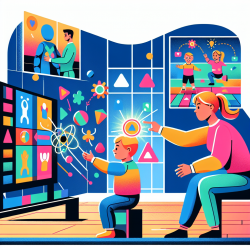As a speech-language pathologist, making data-driven decisions is crucial for improving outcomes for children. Recent research on cognitive visual-motor abilities (CVMA) in individuals with Down Syndrome (DS) offers valuable insights that can be implemented in therapeutic settings to enhance these skills.
The study, "Improving Cognitive Visual-Motor Abilities in Individuals with Down Syndrome," utilized the TANGO:H platform with the KINECT sensor to provide gestural interaction exercises. The goal was to stimulate CVMA, which is critical for integrating vision with motor actions. The study involved six participants divided into an experimental group (EG) and a control group (CG). The EG received cognitive exercises through TANGO:H, while the CG continued with traditional classroom stimuli.
Key findings from the study include:
- Significant improvements in visual comprehension, visual association, visual integration, and visual-motor sequential memory in the EG.
- A decrease in the time required to complete tasks and the number of errors made during exercises over successive sessions.
- Positive observational feedback from experts regarding participants' fluency, understanding, and confidence.
These results suggest that incorporating technology like TANGO:H in therapy can significantly enhance CVMA in children with DS. Here are some actionable steps for practitioners:
- Incorporate Technology: Utilize platforms like TANGO:H that offer gestural interaction to make therapy engaging and effective.
- Monitor Progress: Regularly track improvements in task completion time and error rates to adjust the difficulty of exercises appropriately.
- Engage Experts: Collaborate with other professionals to gain a comprehensive understanding of each child's progress and areas needing improvement.
For practitioners eager to delve deeper into this area, further research and experimentation with different technologies and methodologies are encouraged. The study's findings provide a strong foundation for developing more targeted and effective interventions.
To read the original research paper, please follow this link: Improving Cognitive Visual-Motor Abilities in Individuals with Down Syndrome.










